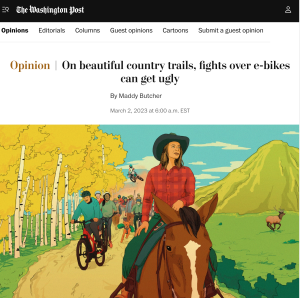Editor’s Note: This piece was published in the Washington Post. But here it is for those of us hitting the paywall.
By Maddy Butcher
 Who gets to use the trails on this country’s public land? And how should they do it?
Who gets to use the trails on this country’s public land? And how should they do it?
The latest debate is about e-bikes. With battery-assisted pedaling, e-bikes allow more people to enjoy nature, including those whose age or disability might otherwise make them unable to venture into these natural settings.
On those terms, e-bikes should be celebrated and welcomed. But critics — and there are many in the backcountry — complain that the increasingly popular e-bikes physically degrade trails. (Any damage is likely just a numbers game: More trail use leads to more damage.) Another common complaint is that using an e-bike is “cheating.” The message: Stick to the streets and the suburbs; you don’t belong out here.
In some of the world’s most stunning open spaces, under big skies and epic panoramas of mountains and meadows, it can get ugly.
Last summer, the Colorado Sun reported on “near-fist fights” over e-bike use on natural-surface trails in the state. But is the e-bike hubbub really about trail degradation and earning your outings, or is it just a sly means of trying to exclude newcomers? I’m not sure.
E-bike sales have been climbing for years, from 1 percent of the bicycle market in 2012 to 15 percent in 2019 before spiking further during the pandemic. More e-bikes were sold in the United States in 2021 (880,000) than electric cars and trucks (608,000). Not surprisingly, more people are taking them into the backcountry.
Given the surge, the Bureau of Land Management and U.S. Forest Service have scrambled to provide guidance regarding access. The BLM released a directive in 2020; the USFS released its guidance last year. Both allow for some local control and decision-making. In other words, the disputes will continue, with shifting rules, subject to geography and e-bike type.
In southwestern Colorado, where I live, mountain bikers, e-bikers, hikers, hunters, anglers, cows and cowboys all share space. Or try to.
I admit to having my own prickliness around increased traffic when I ride a horse on National Forest trails. I’m regularly looking over my shoulder for bikers of any kind. They tend to approach quickly and quietly, like mountain lions. It can be hard to control a thousand-pound prey animal that thinks it’s being chased by a predator.
I note that mountain bikers, heads down, focus granularly on the trail, seemingly oblivious to the flora and fauna around them. ATV riders and dirt bikers seem even less in touch with their surroundings, but at least they’re often restricted to certain areas. (Many e-bike critics would like to see them treated similarly.)
I want everyone to be like me, Nature Gal, quietly taking in the landscape and embracing the outdoors with a certain etiquette and humility. I get testy with upstarts who approach things differently.
Getting testy on trails is normal, Matt De Young, executive director of Santa Cruz Mountains Trail Stewardship, told me, but it isn’t helpful or attuned to the expanding variety of users.
“I think people need to consider whether their argument is stylistic or substantive,” he said, “whether it’s actually an issue or just not fitting with their view of outdoorsmanship.”
Ouch. Mea culpa.
De Young, a mountain biker, finds it ironic that many of his fellow mountain bikers use the trail-degradation argument to oppose e-bike access to trails. For years, he said, mountain bikers were accused of “tearing up the landscape.” He added: “We had to fight quite a lot for access. Now we’re telling that story around e-bikes, too.”
Adding to the pressure on trails, and thus on the wilderness as well: It isn’t just newbies who are using e-bikes.
Consider Conor Cliffe, who has both mountain-biked and e-biked the Raging River trail system in Washington state, with a 3,800-foot elevation gain over nearly 19 miles. On a regular bike, the ride takes him half a day. On his e-bike, he can knock it out in a few hours. “I e-bike to get away from the crowds” on the trail, he told me.
And the more we’re getting away from each other, the more we inevitably disturb wildlife unused to human encounters.
Elk populations around Aspen, Colo., have shrunk by half since 2000, in part because more people are “using more toys to push farther into the woods,” the Aspen Times reported in 2020. The USFS in 2018 studied how recreational trail use affects elk in Oregon. The study found that ATV riders push the animals up to 1 kilometer away from the trail. Bikers and hikers move them, too, and essentially contribute to habitat loss for these large ungulates.
It’s my duty, I suppose, to make nice with the upstart riders on the trails. But the increase in traffic makes me, like Cliffe, want to get away from the crowds. That presents a quandary. A few weeks ago, I broke trail while cross-country skiing for miles across sage and juniper country, accompanied by my dogs. I saw two bald eagles and four dozen elk.
They all moved off when they saw us. I was sorry to disturb them and kept my dogs close, but I didn’t turn back.
Thanks for putting this idea out there in an urban publication. I’m always surprised how some people that live in cities are unaware of issues we equestrians face. It does work both ways and it’s important for all of us to be understanding of the problems of those whose lives and problems are different than what we experience. Ride on!